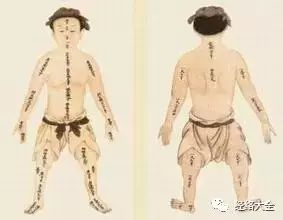New friends: Click the blue text below the title to quickly follow.
Old friends: Click the share button in the upper right corner to share this exciting content.
More information: Open the Acupuncture and Tuina Training Center public platform and click the upper right corner to view historical records.
The collaterals (Bie Luo) are a term in meridian theory, referring to the larger collaterals that branch from the twelve primary meridians to adjacent meridians. Each of the twelve meridians has one collateral, along with the collaterals of the Ren (Conception) and Du (Governing) meridians, totaling fifteen collaterals. As stated in the Nanjing (Classic of Difficulties), Chapter 23: “There are fifteen collaterals, all originating from their source, like a ring without end, mutually irrigating, reaching the pulse at the wrist (Cunkou) and the heart, determining life and death of all diseases.”

The collaterals are also branches that split from the meridians, mostly distributed on the body surface. There are fifteen collaterals, one for each of the twelve meridians, plus the collaterals of the Ren and Du meridians, and the large collateral of the Spleen. Additionally, if we include the large collateral of the Stomach, it can be referred to as the sixteen collaterals.
Hand Taiyin Collateral – Liexue
Foot Taiyin Collateral – Gongsun
Hand Shaoyin Collateral – Tongli
Foot Shaoyin Collateral – Dazhong
Hand Jueyin Collateral – Neiguan
Foot Jueyin Collateral – Ligou
Hand Taiyang Collateral – Zhi Zheng
Foot Taiyang Collateral – Feiyang
Hand Yangming Collateral – Pianli
Foot Yangming Collateral – Fenglong
Hand Shaoyang Collateral – Waiguan
Foot Shaoyang Collateral – Guangming
Collateral of the Ren Meridian – Jiuwai
Collateral of the Du Meridian – Changqiang
Large Collateral of the Spleen – Dabao
The collaterals are a major part of the collateral system and serve as the main trunk, playing a leading role in the numerous small collaterals throughout the body. The small collaterals that branch from the collaterals are called “Sun collaterals,” as mentioned in the Ling Shu (Spiritual Pivot), where it states that “the collaterals that branch are called Sun.”
The collaterals distributed on the skin surface are referred to as “floating collaterals,” as stated in the Ling Shu (Spiritual Pivot), which describes them as “the collaterals that are floating and commonly seen.” After branching from the larger collaterals, the pulse energy gradually becomes finer, closely connecting with the tissues of the trunk.
The collaterals are mostly oblique branches, and their distribution has specific locations:
1. Limbs: The collaterals of the Yin meridians run in the direction corresponding to their Yang counterparts, facilitating communication between the two meridians and supplementing the pathways where the meridians may be insufficient.
2. Trunk: There are three collaterals distributed in the front, back, and sides of the body: the collaterals of the Ren Meridian are scattered in the abdomen; the collaterals of the Du Meridian run along the back, spreading to the head and branching into the Foot Taiyang Meridian; the large collateral of the Spleen is distributed in the chest and lateral areas. This strengthens the unified connection of the body’s front, back, and sides.
Basic Functions
1. Strengthening the connection between the two meridians that correspond to each other in the twelve meridians: This is mainly achieved through the pathways of the Yin collaterals leading to the Yang meridians and vice versa, thereby enhancing the connection between the two corresponding meridians in the limbs. Although the collaterals also connect to the chest and abdominal cavity and the internal organs, they do not have a fixed collateral relationship. The primary focus of the collaterals is to communicate between the Yang and Yin meridians distributed on the body surface.
2. Governing the collaterals throughout the body: The “collateral points” of the twelve meridians are the gathering points and hubs of the pulse energy of the respective collaterals. For example, the collaterals of the Ren Meridian scattered in the abdomen govern the Yin collaterals in that area; although the collaterals of the Du Meridian originate from the Changqiang point, their pulse energy spreads to the head, branching into the Taiyang meridian, thus governing the Yang collaterals in the head and back; the large collateral of the Spleen, distributed in the chest and lateral areas, plays an important role in promoting the flow of Qi throughout the body’s meridians. This not only strengthens the unified connection of the body’s front, back, and sides but also enhances the connection of the collaterals throughout the body.
3. Nourishing the entire body through the diffusion of Qi and blood: The Sun collaterals and floating collaterals that branch from the collaterals are distributed throughout the body in a net-like pattern, with extensive contact with surrounding tissues. This allows the Qi and blood circulating in the meridians to diffuse from a linear flow to a surface area, thus fully exerting their nourishing effects on the entire organism.
Circulation Locations
The distribution of the fifteen collaterals has specific locations, with the collaterals of the twelve meridians branching from below the elbows and knees in the limbs, interconnecting the Yin and Yang meridians; the collaterals of the Ren Meridian are distributed in the abdomen, the collaterals of the Du Meridian are distributed along the back, and the large collateral of the Spleen is located on the sides of the body. The specific circulation locations are as follows:

Sharing is a joy; move your fingers to let more people gain health and happiness.
Long press the following QR code to follow the Acupuncture and Tuina Training Center and learn more about meridian health knowledge.

